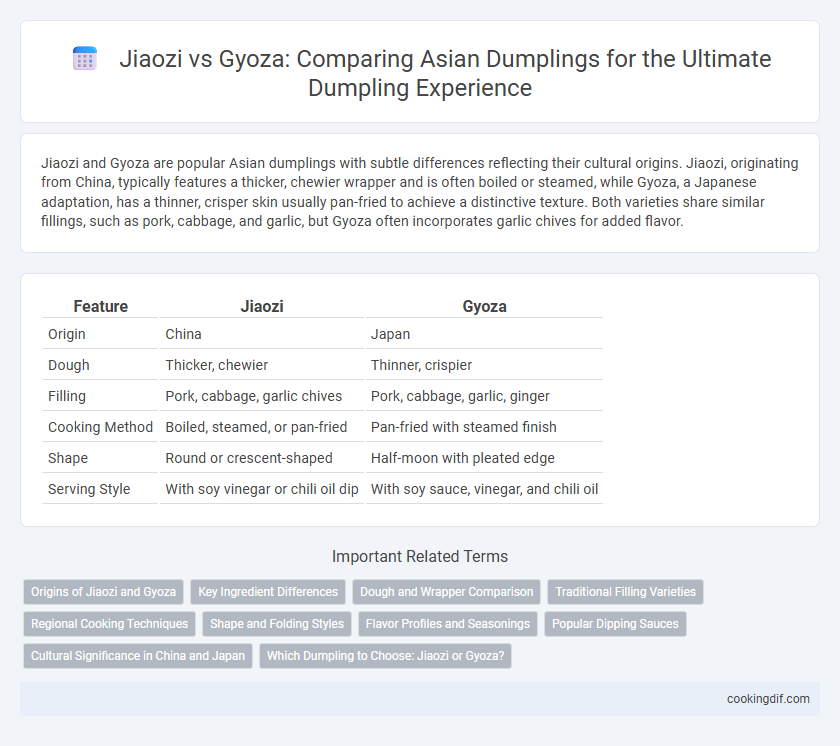Jiaozi and Gyoza are popular Asian dumplings with subtle differences reflecting their cultural origins. Jiaozi, originating from China, typically features a thicker, chewier wrapper and is often boiled or steamed, while Gyoza, a Japanese adaptation, has a thinner, crisper skin usually pan-fried to achieve a distinctive texture. Both varieties share similar fillings, such as pork, cabbage, and garlic, but Gyoza often incorporates garlic chives for added flavor.
Table of Comparison
| Feature | Jiaozi | Gyoza |
|---|---|---|
| Origin | China | Japan |
| Dough | Thicker, chewier | Thinner, crispier |
| Filling | Pork, cabbage, garlic chives | Pork, cabbage, garlic, ginger |
| Cooking Method | Boiled, steamed, or pan-fried | Pan-fried with steamed finish |
| Shape | Round or crescent-shaped | Half-moon with pleated edge |
| Serving Style | With soy vinegar or chili oil dip | With soy sauce, vinegar, and chili oil |
Origins of Jiaozi and Gyoza
Jiaozi originated in Northern China over 1,800 years ago during the Eastern Han Dynasty, traditionally eaten to celebrate the Lunar New Year with fillings of pork, cabbage, and chives. Gyoza, a Japanese adaptation of Jiaozi, was introduced in the early 20th century and features a thinner wrapper, garlic-heavy pork filling, and pan-fried cooking style. Both dumplings reflect cultural heritage through their distinct preparation methods and regional ingredient preferences.
Key Ingredient Differences
Jiaozi typically feature a wheat-based dough filled with a mixture of ground pork, Napa cabbage, garlic chives, and ginger, reflecting traditional Chinese flavors. Gyoza dough is thinner and slightly crispier, often wrapping ground pork blended with garlic, ginger, scallions, and cabbage, highlighting Japanese seasoning preferences. The key ingredient differences lie in the seasoning profiles and dough texture, with jiaozi emphasizing bold, aromatic Chinese spices and gyoza favoring a lighter, savory taste with a delicate wrapper.
Dough and Wrapper Comparison
Jiaozi dough is typically thicker and chewier, made from wheat flour and water without oil, yielding a softer wrapper that holds fillings well during boiling or steaming. Gyoza wrappers are thinner and more delicate, often containing a small amount of oil, which creates a crispier texture when pan-fried. This texture difference allows jiaozi to excel in steamed and boiled preparations, while gyoza's thinner wrapper enhances the signature crispy bottom in yaki-style cooking.
Traditional Filling Varieties
Jiaozi and gyoza are iconic Asian dumplings with distinct traditional filling varieties that reflect their cultural origins. Jiaozi fillings commonly include ground pork, cabbage, and Chinese chives, often seasoned with ginger, garlic, and soy sauce for robust flavor. Gyoza typically features a mix of ground pork, garlic, ginger, and finely chopped cabbage, with a lighter seasoning profile emphasizing sesame oil and soy sauce to create a delicate taste.
Regional Cooking Techniques
Jiaozi are traditionally boiled or steamed in Northern China, emphasizing a thick, chewy wrapper with a juicy pork and cabbage filling, while Gyoza in Japan are typically pan-fried using the yaki method to create a crispy bottom and tender top, with a finer wrapper and garlicky pork and vegetable mixture. Regional cooking techniques influence texture and flavor profiles, with jiaozi favoring a hearty, doughy bite and gyoza prioritizing contrast between crunchy and soft elements. The steaming and boiling of jiaozi preserve moisture inside, whereas the pan-frying of gyoza enhances umami through caramelization.
Shape and Folding Styles
Jiaozi typically feature a crescent shape with a pleated side created by folding one edge over and pinching to seal, often producing multiple evenly spaced pleats. Gyoza, inspired by jiaozi but with a thinner wrapper, are usually more elongated and use a half-moon fold with fewer, tighter pleats focused on one edge. The difference in folding styles influences texture, with jiaozi's thicker seams providing a heartier bite, while gyoza's delicate folds yield a crispier finish when pan-fried.
Flavor Profiles and Seasonings
Jiaozi feature a savory, mildly spiced filling with a balance of ginger, garlic, and soy sauce, highlighting a clean, comforting taste typical of Northern Chinese cuisine. Gyoza present a more intense garlic and sesame flavor, often accompanied by a hint of vinegar or chili, reflecting Japanese preferences for bold, umami-rich experiences. Both dumplings use pork or vegetable fillings but differ in seasoning concentration and dipping sauces, defining their distinct regional flavor profiles.
Popular Dipping Sauces
Jiaozi, the traditional Chinese dumplings, are often paired with a dipping sauce made from soy sauce, black vinegar, and fresh ginger for a tangy and savory flavor profile. Gyoza, the Japanese variant, typically features a sauce blend of soy sauce, rice vinegar, and a hint of chili oil, offering a mildly spicy and tangy taste. Both dipping sauces enhance the dumplings' textures, with Jiaozi sauces emphasizing acidity and warmth, while Gyoza sauces balance sweetness and spice.
Cultural Significance in China and Japan
Jiaozi holds deep cultural significance in China, symbolizing prosperity and unity during Chinese New Year celebrations, often shaped like ancient gold ingots to attract wealth. Gyoza in Japan, while inspired by Chinese jiaozi, reflects Japanese culinary adaptation, emphasizing thinner wrappers and a pan-fried texture that aligns with Japan's focus on subtle flavors and presentation. Both dumplings serve as cultural icons, representing traditional values and festive customs in their respective countries.
Which Dumpling to Choose: Jiaozi or Gyoza?
Jiaozi and Gyoza are both popular Asian dumplings, with Jiaozi originating from China and Gyoza from Japan, each offering distinct flavors and textures. Jiaozi typically features a thicker, chewier wrapper and a savory filling of pork, cabbage, and garlic, while Gyoza has a thinner, crispier skin with a lighter garlic and ginger flavor profile. Choosing between Jiaozi and Gyoza depends on preference for texture and seasoning, with Jiaozi providing a heartier bite and Gyoza delivering a more delicate, pan-fried crispness.
Jiaozi vs Gyoza for Asian dumplings Infographic

 cookingdif.com
cookingdif.com